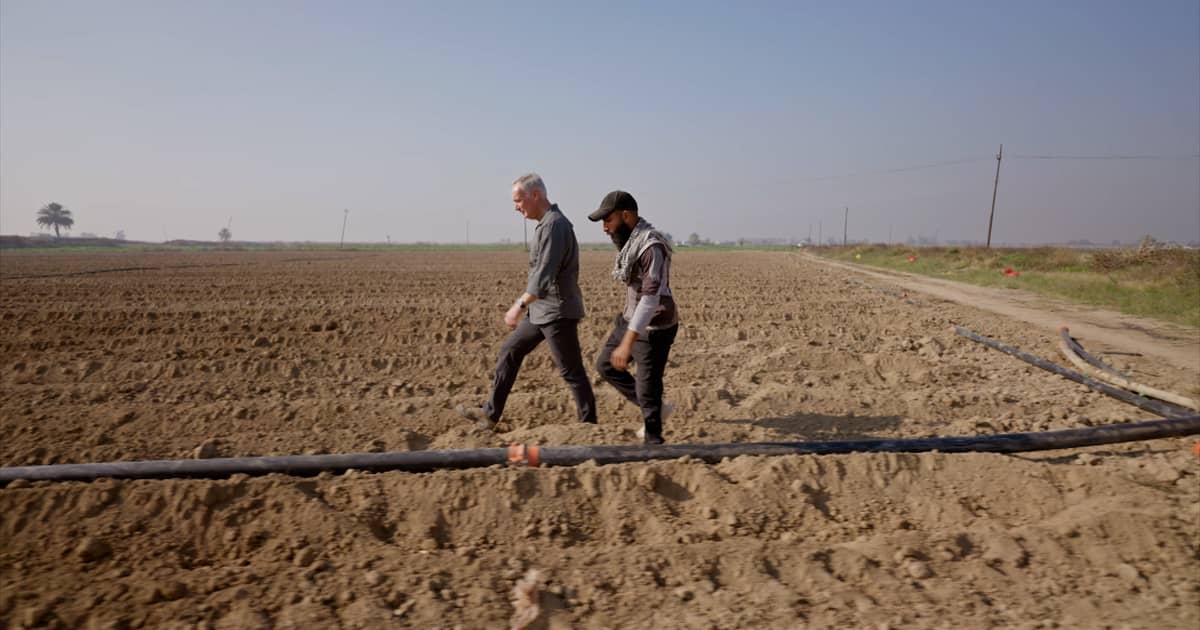A tree at Deltares
It all started with a sculpture of a tree. Verheggen was commissioned to create an art installation for the office of Deltares, a research institute in Delft. He designed a tree with olivine to showcase the mineral’s ability to absorb CO2 from the air. Hoogendoorn, a former Deltares research supervisor, collaborated with him. They discovered that running water with air bubbles over olivine had an unexpected side effect: the bubbles drastically accelerated the CO2 absorption process. “We were surprised to see immediate results, far faster than anticipated,” says Hoogendoorn.
Art, music, and water as a solution
Further experiments revealed that adding vibrations and music sped up the reaction even more. Verheggen created another artwork, where musical tones interact with olivine sand in a box with water. “In just 30 minutes, the CO2 level drops to zero. This demonstrates that we can tackle the world’s biggest problem with art and music,” Verheggen states. “I see many young people losing hope about climate solutions. Through my art, I want to reinvolve them into the discussion. Art is a language everyone understands.”
How to Fight Climate Change?
With their company Carbon Vanish, they want to deploy this technology all over the world, helping to fight climate change. To honor the Paris Agreement and keep the Earth’s temperature increase below 1,5 degree Celsius, CO2 emissions must decrease to zero by 2050. Besides that, large amounts of carbon have to be captured from the atmosphere. For example by planting more trees or capturing and storing the CO2 (CCS).
Olivine is a mineral found in volcanic rocks worldwide. Several studies have shown that it naturally reacts with CO2 in the air to form magnesium carbonate, a harmless kind of chalk, and silica. One ton of olivine can absorb approximately 1.2 tons of CO2. However, under natural conditions, this process can take decades.
Global Experiments
Global projects have explored olivine’s potential. For instance, Vesta Earth added olivine sand to coastal waters near New York, where it reacted with seawater to remove CO2. This technology can now be deployed all over the world’s coast lines. Similarly, Dutch company Peabll has olivine reacting with CO2 to produce raw materials for cement, responsible for 8 percent of the world’s CO2 emissions. Deltares laid olivine-rich rock on footpaths near Rotterdam, designed to naturally sequester 16,000 tons of CO2. But this too will take many years.
designed to naturally sequester 16,000 tons of CO2. But this too will take many years.
Deltares 1A Scientist Meets an Artist
Hoogendoorn, who worked on Deltares’ olivine projects, was inspired by Verheggen’s artistic approach. “As a scientist, I often struggle to convey my message, no matter how passionate I am about the facts. Artists connect with people emotionally, and that resonates better,” Hoogendoorn explains.
A Reactor That Halves CO2 Levels
Their collaboration led to the creation of the “olivine tree.” After the Covid-pandemic, they continued their experiments and developed a groundbreaking reactor. The Carbon Vanish reactor resembles a large cement mixer made from standard materials like stainless steel. When olivine is exposed to a steady stream of bubbles in this reactor, CO2 levels drop from 411 to 216 ppm (parts per million) within hours. The byproduct is a harmless chalk-like substance that can be used in cement production or as a agricultural fertilizer.
The story doesn’t stop here. During all the experiments, they also found a groundbreaking new method to treat the water, increasing the conversion rate even faster. Besides that, team Carbon Vanish has found and has been extensively testing several innovative methods, allowing the process to proceed quickly, with low energy. Also the start-up applied for a patent.
Scaling Up: Toward a Global Solution
They envision mobile installations deployable worldwide, such as near high-emission industrial sites like Rotterdam’s port. According to Hoogendoorn these reactors could provide a cost-effective alternative to expensive carbon capture and storage projects, such as the North Sea Porthos project.
The next step for Carbon Vanish is building a pilot plant, for which the startup is actively seeking private funding. “We need to scale up to show our real impact”, says Hoogendoorn.
The Future: A Planter Box in Every Garden?
How do they see the future? Will everyone someday have a large planter box in their garden, in which olivine, aided by water, air bubbles and music, removes CO2 from the atmosphere, thus offsetting the carbon footprint of their latest flight trip? The idea intrigues the founders. “We hadn’t thought of that, but it’s a great concept,” Hoogendoorn admits.
Read more

Deltares laid olivine-rich rock paths near Rotterdam
To cut CO₂ emissions, the Hoekse Lijn used greenSand, an olivine-rich material, for semi-paved surfaces along its 24-kilometre railway strips. While the project is successful, the CO₂ removal process remains long.

Deltares: olivine field trials
Knowledge institute Deltares has published a research report on the weathering of the Olivine rock. You can read more about the field trials here ...

Ap Verheggen is also able to create water in the desert
It's not the first time we hear how Ap Verheggen tackles big problems. He showed the world how to create around 1200 liters of water per day in the desert.